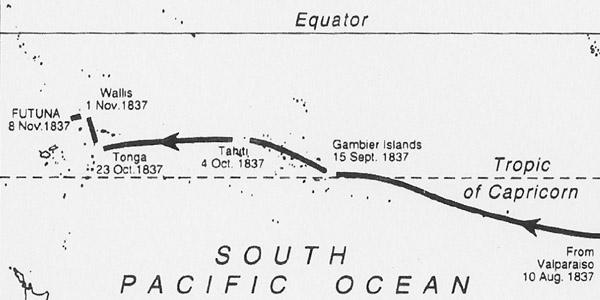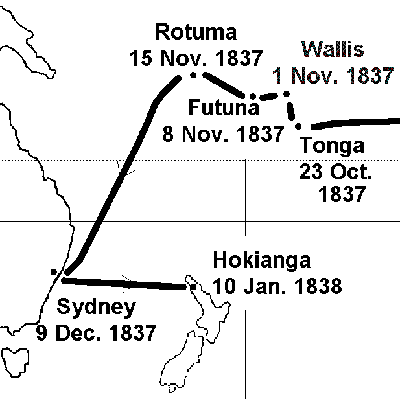APAC63
From Marist Studies
Contents
Futuna
- They must have had a very fine sea and wind, because they did the 225 km in a good day and reached Futuna on 8 November.[1] Once there he found the people open to the suggestion of having a missionary on the island. In fact, one Futunan had worked on an Australian whaler, had visited Sydney, spoke a bit of English and recognised the Marists as Catholic priests. He invited them to stay.
- Now Pompallier had to choose between Futuna and either Rotuma or far away Pohnpei. Opting for Futuna would allow the two missionaries to keep in contact. So, in discussion with his missionaries the bishop changed plans again, put off Pohnpei for the time being and decided to leave Peter Chanel and Brother Marie-Nizier on Futuna. As on Wallis they too got a house near that of the king, Niuliki, king of Alo, which they hoped would give them a sort of official protection. They moved in there on 12 November. Having understood that there were two kingdoms on the one island of Futuna, one in Alo and another one at Sigave, Pompallier left them with some goods to use as presents for the other king.[2]
- On 13 November Bishop Pompallier, Father Servant and Brother Michel left Peter Chanel behind on the beach, with Brother Marie-Nizier and Thomas Boag, who asked to be allowed to stay with the two missionaries. The Raiatea took fourteen shipwrecked sailors on board who were stranded on Futuna, and sailed for Rotuma, some 200 km to the West, where they arrived on 15 or 16 November. There too they were well received but Pompallier had no missionaries left, and could only promise the local people of whom he had heard favourable information that he would return with a missionary. Six sailors stayed on Rotuma that they knew was regularly visited by whalers. The Raiatea left after one day and set sail directly for Sydney, taking the remaining sailors along.[3]
Colin receiving mail
- Pompallier’s first letter from Valparaiso, sent on 17 July by the Hudson, announcing the death of Claude Bret, arrived on 13 November, the day after its writer had left Chanel and Marie-Nizier on the beach of Futuna island, staring after the Raiatea. It came in a packet of letters, just before dinner. He quickly opened them, glanced at the signatures, and went to dinner. On the way down, and all the way during dinner, he kept wondering. ‘But there is one who has not written! Why has Father Bret not written? That is not nice of him’. It was only after dinner, when he started reading that he found out. ‘He could not write, because he is dead!’ Colin burst out in tears. ‘God be praised! Let His will be done’. He called the community together in the chapel to tell them.[4] In the same packet Colin received Pompallier’s second letter, dated on 20 July and sent via the Télégraphe.
- The packet also contained the bishop’s letter to his mother with the personal letters from all the missionaries, Pompallier’s letter to the parents of Claude Bret plus a few other ones, among which were letters from Peter Chanel to his sister Françoise and his family.
- Colin would have read all the letters and he forwarded those addressed to other persons. He did not sit down immediately to write back. The absence of any definite information on the whereabouts of the missionaries may have held him back. From the letters received he had to conclude that the missionaries would be in Hawaii, still on the way to Pohnpei, or possibly already there. He too would now see the need for a procure, although Pompallier’s writing did not yet answer the question where: Valparaiso was out, but California, Hawaii and Sydney were all possibilities. Not much to take action on!
- On 27 November Colin decided to write to Pompallier anyhow and he invited others to do the same. The letter has not been preserved but we know he told Pompallier of the 8.700 francs sent in May. He sent the parcel to the Picpus Fathers in Valparaiso, so far the only sure point in the equation. It did not reach Pompallier until March 1839, i.e. fifteen months later![5]
- On 1 December Fr. Colin wrote to Cardinal Fransoni to tell him that the missionaries had arrived in Valparaiso, but that, helas, one had died in mid-ocean. At the time of writing, he could say, i.e., in July, they had been readying themselves to continue their journey. Reflecting Pompallier’s abrupt change of plans he cautiously added: ‘We can presume, if nothing untoward has happened to them, that by now they will be among their island people’.[6]
- The third batch, with a copy of the letter for the minister of the navy in Paris, and a letter from Bataillon to Étienne Séon, that had all been sent by overland courier via Montevideo and Buenos Aires, arrived much later, somewhere between 1 December and 10 January 1838, although Bataillon had thought that the overland courier would be quicker.[7]
The end
- It took the Raiatea with Bishop Pompallier, Catherin Servant and Michel Colomb a month to cover the distance from Rotuma to Australia. On 9 December they sailed into Sydney harbour, just when a violent tropical storm hung over the town. It could not dampen their joy. The three Marists were most graciously received by Bishop Polding and invited to stay in Polding’s own residence where they celebrated Christmas together.
- Again there were no letters waiting in Sydney for Pompallier, Servant or Brother Michel. No letters, no news, no money. However, there were so many exciting things to tell that in his first letter, dated 23 December 1837, he kept it to a frustrated sigh: ‘How much would I love getting an answer to all the letters I sent to Europe!’. Undeterred he recounted all the good news, of Wallis and Futuna, and of the advantages and the facilities that Sydney, and only Sydney, could provide.
- Bishop Polding offered to take care of mail to and from France. An Irish priest in the Bishop’s house, John McEncroe, was to be Pompallier’s agent. They were given a room in the newly built seminary to store the goods they did not want to take along immediately. The governor of the colony made special arrangements for the mission goods to pass through customs even though they were brought in on a Tahitian ship from a non-British port. They found out that mission goods sent from France could enter Australia on the same conditions as goods from Britain irrespective of what ships, British or French, they arrived on, provided French ships had come without commercial stops on the way. All mail, all personnel, all goods should from now on come the shorter, safer and much cheaper way of London-Sydney. He urged Colin to send him reinforcements as soon as possible, specifically two Brothers to start the procure. A priest with them would be very useful, but on that point he hesitated. Priests were badly needed elsewhere and the long-term presence of a French priest in Sydney could cause problems.[8] There must have been something in his contacts with Archbishop Polding that made Pompallier think so.
- Of particular concern was his financial situation. He had practically nothing left now and he had promised to visit Wallis and Futuna within five or six months. The trip would cost some four or five thousand francs. The sort of house needed for a procure would cost about 20.000 francs.[9]
- Bishop Polding gave Pompallier a letter of introduction to Thomas Poynton, a Catholic Irish settler on the Hokianga River in New Zealand, who had a trade-store and a sawmill there. Poynton’s Australian-born wife had become a Catholic and had travelled to Sydney to have her first daughter baptized. Poynton himself had come to Sydney when Bishop Polding arrived there in 1835, and he had asked for a priest. The Governor of New South Wales gave Pompallier a letter of recommendation to James Busby, the British resident in the Bay of Islands, and Polding gave him a similar document for Thierry who had just returned to New Zealand.[10]
- On 30 December 1837 Bishop Pompallier, Father Catherin Servant and Brother Michel Colomb left Sydney on the Raiatea and on Wednesday, 10 January 1838, three hundred and eighty-three days after leaving Le Havre, the first Marist missionaries sailed up the Hokianga river, on the north-west coast of the North Island of New Zealand.[11]
Notes
- ↑ It usually took two and a half days to sail between Futuna and Wallis, cf. EC, doc. 39 [2], & p. 336 & 345.
- ↑ LRO, doc. 22 [5]. Wiltgen op. cit., p. 159. Ronzon, Delorme, pp. 53ff. Either they had an exceptionably favourable wind, or their dates got mixed up by the date line, which happened again with the second group, cf. LRO, doc. 32, p. 266, n. 7! Although more than 200 km apart, there were regular contacts between the two islands. During Chanel’s first year there, we know of six opportunities to travel or send letters. In his later report Pompallier mentions explicitly that he discussed the decision to opt for Futuna with his missionaries. Cf. Pompallier, op. cit., p. 43. Cf. Jore, op. cit., II, p. 154.
- ↑ Wiltgen, op. cit., pp. 159f.
- ↑ FA, 216, n. 1, from MM 7, 815. There is an unexplained discrepancy in the dates: 13 November is well attested, but on 27 October Pierre Colin is recorded to have told a group of Lay-Marists of the safe arrival of the missionaries in Valparaiso! Cf. ML, doc. 37 [4]. If news had reached Pierre Colin three weeks earlier, how is it possible that Jean-Claude had not heard about it? Cf. LC, doc. 158.
- ↑ Pompallier to Meynis, 17.03.39, OPM H30, 000867. Cf. below, p. 113.
- ↑ CS, doc. 23.
- ↑ Cf. above, p. 55f. Colin mentions the letters of 17 and 20 July to Fransoni on 1 December. In his circular letter of 10 January 1838 he mentions the third letter of the 27th (in fact sent early August) as having just arrived. L`Ami de la Religion carried the news on 25.01.1838 (96), p. 169.
- ↑ LRO, doc. 22, introduction and [6]. A copy was sent in March from New Zealand via Valparaiso. Cf. CS 54 [2]. The letter was published in the Annales de la Propagation de la Foi, LXI, November 1838, pp. 70 ff.
- ↑ He landed in New Zealand with £ 113. 8s. & 6d. (about 1.200 Francs) which enabled him to build the house at Papakawau (Simmons, op. cit., p. 35, Diocesan Archives of Auckland). LRO, doc. 22 [7].
- ↑ LRO, doc. 22 [5], n. 10. Jore, op. cit., I, pp. 188ff. Wiltgen, op. cit., p. 203f. Jaspers, op. cit., p. 193f.
- ↑ LRO, doc. 26 [3]. Simmons, op. cit., p. 28.
| Previous Section | A Piety Able to Cope | Next Section |


